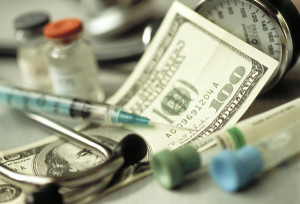The Centers for Medicare and Medicaid issued a report covering the trajectory of healthcare expenditures in the United States and found that in 2013, spending only went up by 3.6 percent. With a heavily conservative Congress, it seems likely that the dismantling of the Affordable Care Act may be on top of the Congressional to do list. While the spending increase has been consistent over the last several years, it has also been relatively slow; the data doesn’t suggest an enormous, irreversible spike initiated by the ACA. However, the slow-creep of rising expenditures is still troubling.
That 3.6 percent translates into approximately $2.9 trillion dollars. Breaking it down even further, that’s roughly $,9255 per person. Since 2009, nearly one-fourth of the nation’s GDP has been devoted to healthcare spending. Where’s all that money going?
Hospitalizations
Hospital spending rose by 4.3 percent, to $936.9 billion. We can attribute this increase to the overall rise in price across the board for services as well as higher rates of utilization. Medicare and private insurance spending decreased on average for hospitalizations, while Medicaid payments remained relatively unchanged from 2012.
Physicians
It might not be all that surprising that costs from physician and clinical services rose accordingly. The growth — to 3.8 percent—has been slow going in part because of the sequester and zero percent payment update from last year. Pairing this with increased payouts, Medicaid spending also rose slightly.
Who’s Paying Up?
The overall expenditure can be divvied up between Medicare, Medicaid, the private sector and out of pocket costs to patients. For the most part, the percentages have remained fairly consistent for the last several years, but with the congressional changes and ongoing pledge to reform healthcare, we might see some important shifts in the next year.
As it stands now, Medicare accounted for 20 percent of the nation’s healthcare spending. This has slowed down accordingly, as enrollment in the Affordable Care Act hadn’t risen much when the data was being reported.
Medicaid, on the other hand, accounts for about 15 percent; around $449 billion dollars on the federal side. Local Medicaid payments account for about 5.9 percent.
The private sector saw an increase that correlated to the slight rise in enrollment, with premiums topping $961 million.
And out of pocket costs, which account for around 12 percent, actually dropped by 3.2 percent — down from 3.6 percent in 2012.
The rise in patient spending — or, household responsibility—rose to 3.5 percent, in part due to the increase in employee contributions to private sector health insurance plans. Federal spending also rose, in accordance with increased Medicaid payments to PCPs that were mandated by the ACA. Interestingly enough, overall spending actually decreased as we saw the expiration of the American Recovery and Reinvestment Act of 2009.
State and local spending rose by 3.2 percent with the cessation of federal matching rates for Medicaid programs. The private business sector saw a 4 percent increase due to declining enrollment — a casualty of the economic recession.
What Will 2015 Bring in Healthcare Payment Reform?
As new medical technologies continue to emerge, we’re likely to continue to see a trend of rising healthcare spending. As the market prices are driven up by innovations, and demand increases, we remember that healthcare is a business. Whether or not that model is the most sustainable, it’s the reality we’re working in.
We’re also going to see increased demand as more patients acquire coverage through Obamacare. The problem is, it’s not clear if the supply of physicians—particularly GP’s—will be able to withstand the influx of patients. 2014 wasn’t a terrible year for those who had become insured through Medicaid, as the price to access care was reasonable by previous standards. Unfortunately, 2015 sees those prices reverting back to their rather subpar numbers.
As demand for services increases, and access remains limited, we’re likely to continue to struggle with high utilization of emergency services, which has been a notoriously costly problem in the United States for decades. Though, as co-payments and other out of pocket costs continue to rise, it’s possible that utilization of any and all health services will decline if patient’s can’t pay.
Accountable Care Organizations continue to form nationwide, and the hope is that these will help address many of the aforementioned dilemmas in healthcare. While many are still admittedly “on the fence” about the efficacy of the program, as we enter the fifth year of the Affordable Care Act, it will be interesting to review the stats as the data from the last few years rolls in.

